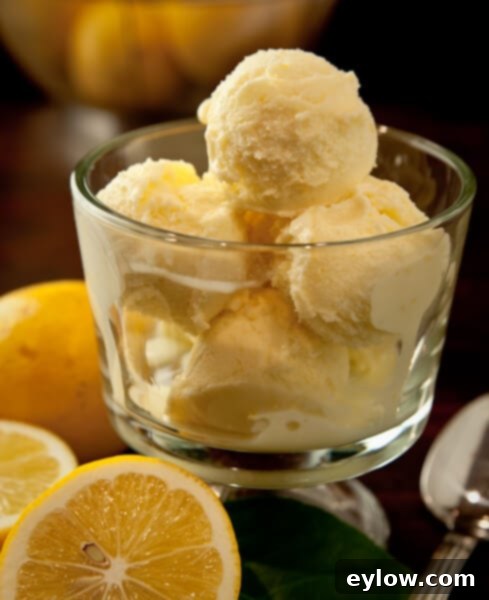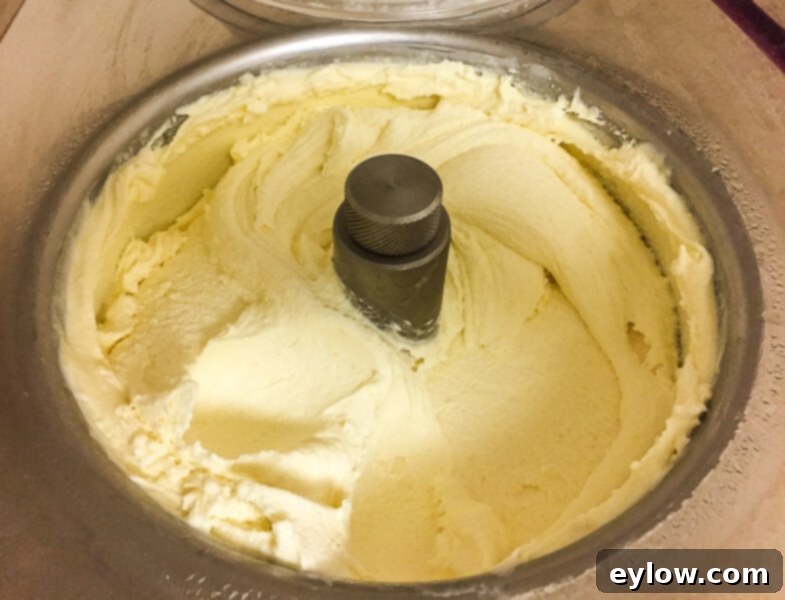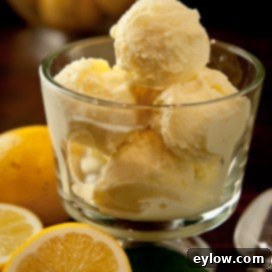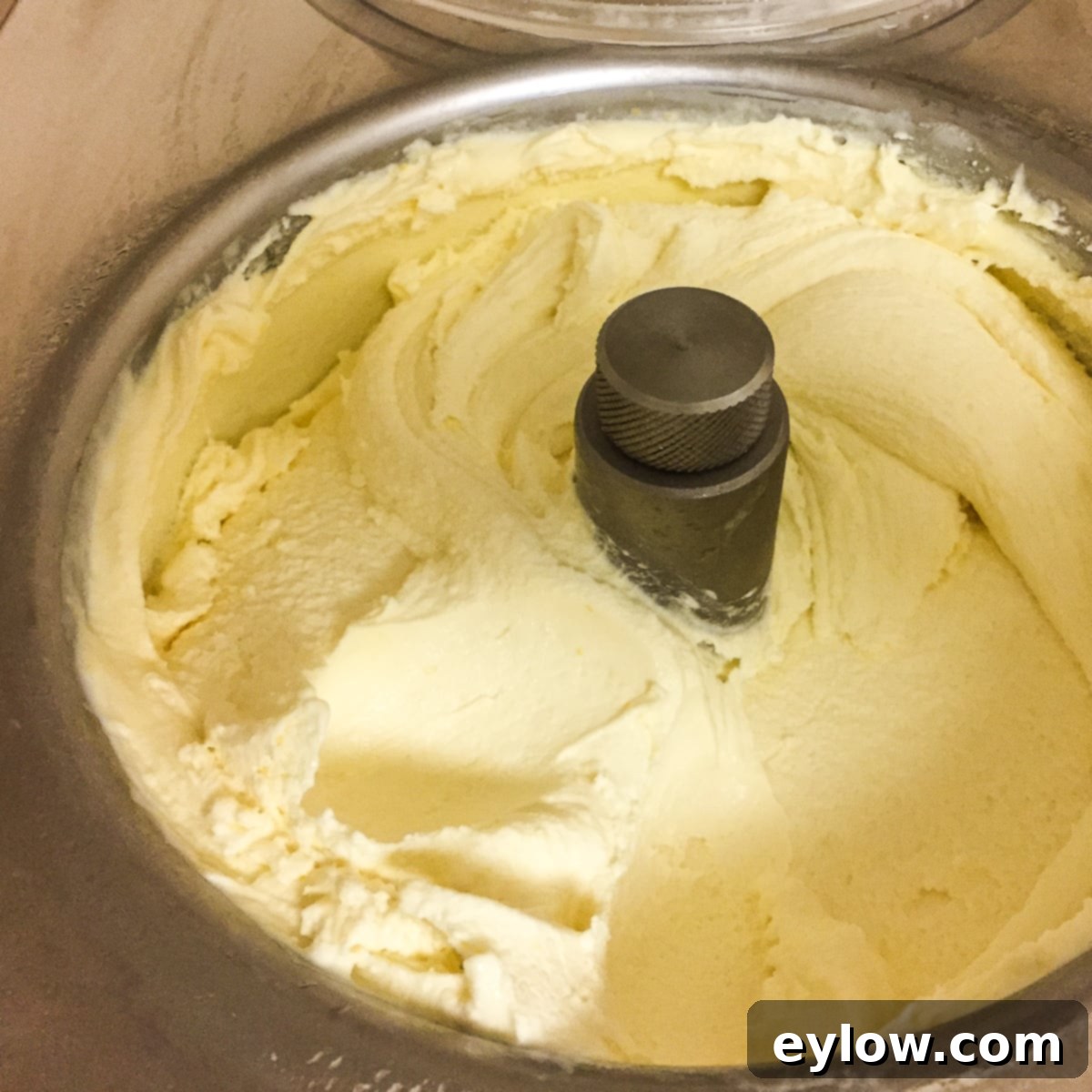Homemade Lemon Custard Ice Cream: Creamy, Tart, and Refreshing Summer Treat
Imagine pure bliss in every spoonful – that’s what you get with this homemade lemon custard ice cream. Bright, delightfully creamy, and perfectly tart, it’s like capturing the essence of a sun-drenched day in a bowl. This isn’t just any ice cream; it’s a rich, French-style frozen custard made with a luxurious egg yolk base, ensuring an ultra-smooth, velvety texture that simply melts in your mouth. The exquisite balance of sweet and tangy lemon flavor makes it an irresistible indulgence, whether you’re seeking a cool reprieve on a sweltering afternoon or simply craving a vibrant, citrusy dessert. Prepare to impress your taste buds and those of any ice cream aficionado with this luscious, homemade delight.

Custard-based ice creams are celebrated for their unparalleled richness, superior creaminess, and wonderfully smooth consistency. This is primarily due to their foundation: a base thickened with egg yolks, which provides a denser, more luxurious mouthfeel compared to standard ice cream. Often referred to as “frozen custards” or “French-style ice creams,” these creations stand apart. The use of egg yolks acts as a natural emulsifier and stabilizer, preventing the formation of large ice crystals that can lead to an icy, gritty texture. As a result, custard ice creams not only taste incredibly decadent but also scoop out of the freezer with remarkable ease, remaining soft and pliable even after extended freezing. This lemon custard ice cream recipe exemplifies these qualities, making it a perennial favorite for its delightful flavor and impeccable texture that truly elevates the dessert experience.
Why You’ll Love This Creamy Lemon Ice Cream Recipe
This recipe isn’t just about making ice cream; it’s about crafting an unforgettable dessert. Here’s why this homemade lemon custard ice cream will quickly become a cherished favorite:
- Unrivaled Texture: Thanks to the rich custard base, this lemon ice cream boasts an incredibly smooth, dense, and creamy texture that feels utterly luxurious on the palate. It avoids the icy pitfalls common with many homemade versions.
- Surprisingly Simple to Make: While the term “custard” might sound intimidating, the process is straightforward with the right tools. An ice cream maker does most of the heavy lifting, turning your perfectly prepared base into a dreamy dessert with minimal effort.
- A True Celebration for Lemon Lovers: If you adore the bright, tangy flavor of fresh lemons, this recipe delivers it in spades. It captures the vibrant essence of lemon without being overly sour, offering a refreshing and exhilarating taste experience.
- Perfect for Any Occasion: Elegant enough for a dinner party yet comforting enough for a casual treat, this lemon custard ice cream is versatile and always a crowd-pleaser.
- Customizable Sweetness: You have control over the sugar levels, allowing you to adjust the tartness to your personal preference, ensuring a perfectly balanced flavor profile every time.
Essential Ingredients for Lemon Custard Ice Cream
Creating this exquisite lemon custard ice cream requires just a few high-quality, fresh ingredients. Here’s what you’ll need to add to your shopping list to achieve that perfect balance of creaminess and bright citrus flavor:
- Dairy (Heavy Cream & Whole Milk): The foundation of any rich ice cream lies in its dairy. We combine both heavy cream for decadent richness and whole milk to balance the fat content, ensuring a luscious yet not overly heavy base. This blend contributes significantly to the signature smooth texture of custard ice cream.
- Fresh Lemons (Zest & Juice): The star of the show! For an intense and authentic lemon flavor, you must use both the finely grated zest and freshly squeezed juice from ripe lemons. The zest contains aromatic oils that provide a powerful, vibrant lemon essence, while the juice delivers the characteristic tanginess. Avoid bottled lemon juice for the best results.
- Granulated Sugar: Beyond just sweetness, sugar plays a crucial role in the texture of ice cream by lowering its freezing point, which helps keep it scoopable and prevents excessive iciness. Natural granulated sugar provides the ideal balance here, though alternatives like allulose can be used for a lower-carb option (see notes below for details).
- Egg Yolks: These are the secret to the signature velvety texture of custard ice cream. Egg yolks thicken the base into a smooth, rich custard, acting as a natural emulsifier that prevents ice crystals from forming. Only the yolks are needed for this recipe, giving the ice cream its characteristic French-style richness.
For precise measurements, please refer to the detailed recipe card further down this page.
If your love for lemons extends beyond ice cream, you might also enjoy this delightful lemon olive oil cake, another fantastic citrusy dessert.
Chef’s Tip on Lemons: The choice of lemon can subtly influence the flavor profile of your ice cream. I personally adore cooking with Meyer lemons and am fortunate enough to grow them. With their smoother skin and slightly rounder shape, Meyer lemons are known for being a touch sweeter and possessing a more floral aroma than the standard Eureka or Lisbon lemon. They are, in fact, a natural hybrid between a common lemon and a sweet orange or mandarin. If Meyer lemons aren’t readily available in your area, don’t worry—regular lemons will work perfectly well and still yield a wonderfully tart and refreshing ice cream. Always choose fresh, organic, and untreated lemons when possible, especially since you’ll be using the zest for maximum flavor.
Step-by-Step Recipe Instructions
Making homemade lemon custard ice cream is a rewarding process that yields incredible results. Follow these steps carefully for a smooth, creamy, and flavorful dessert:
Before You Begin: Prepare an ice bath. Fill a large bowl about halfway with ice and cold water. This will be crucial for rapidly cooling your custard base later, preventing it from overcooking and helping it reach the optimal temperature for churning.
Step 1: Infuse the Dairy with Lemon Zest. Begin by combining the heavy cream and whole milk in a medium-sized, heavy-bottomed saucepan (approximately 3-quart capacity). Place it over medium heat. As the dairy warms, add the finely grated lemon zest. Once the mixture is hot (but not boiling), reduce the heat to low. Allow the lemon zest to gently infuse its aromatic oils into the dairy while you prepare the egg and sugar mixture. This slow infusion ensures a deep, natural lemon flavor throughout your ice cream.
Step 2: Whisk Egg Yolks and Sugar. While the lemon zest infuses in the dairy, take a separate medium-sized bowl. Add the egg yolks and granulated sugar. Whisk these two ingredients vigorously until the mixture becomes pale yellow, thick, and smooth. This process not only combines them but also lightens the texture of the yolks, preparing them for tempering.
Step 3: Temper the Egg Yolks. This is a critical step to prevent your egg yolks from scrambling. Carefully ladle about a quarter cup of the hot, lemon-infused dairy into the bowl with the whisked egg yolks and sugar. Whisk continuously and thoroughly until smooth. Repeat this process two more times, gradually increasing the temperature of the egg mixture. Tempering slowly brings the yolks up to temperature, allowing them to blend seamlessly with the hot dairy without cooking into lumps. Finally, pour the tempered egg yolk mixture back into the saucepan with the remaining hot dairy on the stove. This is where patience is key, but the thickening process doesn’t take long.
Step 4: Cook the Custard to Perfection. Return the saucepan with the combined mixture to medium-low heat. Continue to cook, stirring constantly with a whisk or a heat-proof spatula. You will feel the custard gradually begin to tighten and thicken. The custard is perfectly done when it’s thick enough to coat the back of a spoon, and when you run your finger across the spoon, it leaves a clear line. Immediately remove the saucepan from the heat to prevent overcooking. Stir in the fresh lemon juice and a pinch of sea salt. The salt enhances all the flavors, balancing the sweet and tart notes.
Step 5: Rapidly Chill the Custard Base. Transfer the hot lemon custard into a clean bowl and immediately nestle it into the prepared ice bath. Stir the custard frequently for about 5-7 minutes to help it release its heat quickly. This rapid cooling is essential for food safety and for achieving a smoother final ice cream texture. Once the custard is cool to the touch (ideally below 70°F or 21°C), pour it through a fine-mesh sieve into another clean container. This step catches any tiny bits of cooked egg yolk or lemon zest, ensuring an ultra-smooth base. Cover the container and refrigerate for at least 1-2 hours, or preferably longer, until the base is thoroughly chilled—the colder, the better for churning.

Step 6: Churn and Freeze. Once your lemon custard base is thoroughly chilled, pour it into the freezer bowl of your ice cream maker. Process according to your manufacturer’s directions. Churning typically takes 20-30 minutes, resulting in a soft-serve consistency. For a firmer, more scoopable ice cream, transfer the freshly churned ice cream into an airtight freezer-safe container, cover, and freeze for at least 4-6 hours, or until solid.
Chef’s Tip on Pans: When you’re making a delicate custard, the type of saucepan you use makes a significant difference. A heavy-bottomed pan is highly recommended because its weight helps distribute heat gently and evenly across the base. This even heat distribution is crucial for cooking the egg yolks without causing them to scramble or stick to the bottom, which can lead to a lumpy custard. While almost any quality 3-quart heavy pot will suffice, I personally find a saucier pan to be an excellent investment for custards and sauces. A saucier features sloped, rounded sides, which makes whisking and stirring much easier and more efficient, ensuring every part of the mixture is evenly cooked and preventing any scorching in the corners. It’s a versatile addition to any kitchen, perfect for many more tasks than just this lemon custard ice cream, like my beloved risotto!
Serving and Storage Suggestions
Once your delightful lemon custard ice cream is ready, the serving possibilities are endless, and proper storage ensures its creamy texture for days to come.
You can enjoy this lemon ice cream either soft-serve style, directly out of the machine for an immediate treat, or you can freeze it for a few hours to achieve a firmer, more traditional scoopable consistency. For an extra touch, garnish with a sprinkle of fresh lemon zest or a few berries. This ice cream pairs beautifully with fresh fruit tarts, shortbread cookies, or even a dollop on a slice of pound cake. And if you’re serious about serving ice cream, investing in the absolute best ice cream scooper will make portioning a breeze, allowing you to create perfect, effortless scoops every time.
Chef’s Tip on Ice Cream Storage: Proper storage is key to maintaining the smooth, creamy texture of your homemade ice cream and preventing it from becoming icy or developing freezer burn. I’ve experimented with countless containers over the years—from metal loaf pans to various plastic and paper tubs. My absolute favorite and the one I now exclusively use is a specific type of ice cream tub designed for freezer storage. These containers are excellent because they’re freezer-safe, keep air out, and seal in flavor with a tight-fitting silicone lid. While I appreciate the concept of oval-shaped containers that claim to promote easier scooping, I still find myself reaching for a good old-fashioned round tub. The most important factor is choosing a container that can be filled right to the top, minimizing air exposure, which is the primary culprit behind ice crystal formation.
Recipe FAQs
While any fresh lemon will yield delicious results, I personally favor making lemon ice cream with Meyer lemons. Meyer lemons are a unique variety, a hybrid of a lemon and a mandarin orange, which gives them a slightly sweeter, less acidic profile and a distinctively floral aroma compared to standard Eureka or Lisbon lemons. Their zest is particularly fragrant. However, don’t feel limited if Meyer lemons aren’t available; standard lemons work perfectly well and will still provide that classic bright, tangy flavor. Always prioritize what’s in season and looks best at your local market. For the purest flavor, especially since you’ll be using the zest, I highly recommend sourcing organic, untreated lemons to avoid any unwanted chemical residues. You can often find them online as well. If you live in a temperate climate, consider growing your own Meyer lemon tree – they thrive both in the ground and in containers!
To achieve a truly vibrant and intense lemon flavor in your ice cream, you need to rely on fresh lemons, not the bottled juice. The key is to utilize both the lemon juice for its tartness and, most importantly, the finely grated lemon zest. The zest contains essential oils that carry the majority of the lemon’s aromatic compounds, delivering that “big” flavor. When zesting, be careful to only remove the yellow outer layer, avoiding the bitter white pith underneath. For an even more profound lemon boost, especially if your lemons aren’t as fragrant, a clever trick is to add a couple of drops of food-grade lemon essential oil to the chilled ice cream base before churning. This can significantly amplify the citrus notes without adding extra liquid or acidity.
Achieving the perfect balance between sweetness and tartness is crucial for lemon ice cream. The primary way to do this is to control the amount of sugar. You want enough sugar to ensure a creamy texture and pleasant sweetness, but not so much that it overwhelms the natural, refreshing tartness of the lemon. Remember that lemons can vary in their acidity and flavor depending on the variety and season, so it’s always a good idea to taste your chilled custard base before churning. This allows you to make minor adjustments. If it’s too tart, a tiny bit more sugar can be dissolved in. If it’s too sweet, a small dash more lemon juice can brighten it, though be cautious not to add too much liquid at this stage. Trust your palate!
Several factors contribute to preventing your homemade ice cream from becoming overly icy or rock-hard in the freezer. Firstly, the rich custard base with egg yolks naturally helps to create a smoother, denser consistency. Secondly, the type of container you use for freezer storage makes a significant difference. I’ve found that high-quality, freezer-safe containers that can be filled almost to the top and seal tightly with a silicone lid are superior. These types of containers minimize air exposure, which is the main cause of ice crystal formation and freezer burn. Another critical element is sugar. Sugar is not just for sweetness; it acts as an anti-freeze, lowering the freezing point of the mixture and contributing to a softer, more scoopable texture. While sugar substitutes like allulose are great for lower-carb options, they don’t always offer the same anti-freeze properties as traditional sugar, meaning ice cream made with substitutes can sometimes become icier or harder after prolonged freezing. If using substitutes, plan to consume the ice cream sooner rather than later for the best texture.
More Refreshing Lemon Recipes
If you’re a fan of the bright, invigorating flavor of lemon, you’re in for a treat! This versatile citrus fruit shines in countless dishes, both sweet and savory. For another truly lovely and light lemony dessert, you absolutely must try this lemon mousse – it’s an all-time favorite lemon recipe that offers a different, yet equally delightful, texture and experience.
- Easy Blender Lemon Chicken Marinade
- Lemony Mediterranean Pasta Salad Recipe
- Super Moist Lemon Olive Oil Cake Recipe
- Lentil Quinoa Salad with Lemon Vinaigrette
⭐️ Did You Make This Recipe?
We absolutely love hearing from you! If you’ve tried making this incredibly delicious lemon custard ice cream, please take a moment to add your comment below. Your feedback is invaluable, and we genuinely enjoy hearing about your culinary adventures. If you loved it as much as we do, please consider giving it a 5-star rating! Your ratings and reviews not only help other readers discover this fantastic recipe but also support our passion for sharing great food.
📖 Recipe

Lemon Custard Ice Cream
Sally Cameron
Prevent your screen from going dark
Pin Recipe
10 minutes
15 minutes
6 hours
6 hours
25 minutes
Dessert, Ice Cream
American
6
servings
432
kcal
Equipment
-
Ice Cream Maker
Ingredients
-
2
cups
heavy cream -
1
cup
whole milk -
2
tablespoons
finely grated lemon zest
use a microplane zester for best results -
⅔
cup
granulated sugar
or ¾ cup powdered allulose for a sugar-free option, refer to notes for details. -
5
large
egg yolks -
⅔
cup
fresh lemon juice
typically from 3 large lemons -
pinch of sea
salt
Instructions
Preparation Setup
-
To create an efficient ice bath, fill a large bowl about three-quarters full with ice and cold water, then set it aside. This will be used to quickly cool your custard base. Place a clean medium bowl into this ice bath and position a fine-mesh sieve on top; this setup will be ready for straining and cooling the hot custard.
Prepare Your Lemons
-
Carefully zest your lemons using a microplane zester to get approximately 2 tablespoons of finely grated zest. Be sure to avoid the bitter white pith. Then, squeeze and strain the lemons to yield about ⅔ cup of fresh lemon juice. Having these prepared in advance streamlines the cooking process.
Cook the Velvety Custard Base
-
In a medium-sized, heavy-bottomed saucepan (around 3 quarts), combine the heavy cream and whole milk. Add the finely grated lemon zest. Place the saucepan over low heat, allowing the dairy to gently warm and the lemon zest to infuse its wonderful aroma. Keep an eye on it while you prepare the egg mixture.
-
In a separate medium bowl, whisk together the granulated sugar and egg yolks until the mixture is thick, pale, and completely smooth. This ensures a uniform texture in your custard.
-
Bring the dairy mixture in the saucepan to just under a simmer – you’ll see small bubbles forming around the edges, but it shouldn’t be boiling. Carefully ladle a ¼ cup of this hot dairy into your egg yolk mixture, whisking continuously and vigorously until it’s smooth. Repeat this “tempering” process 3-4 more times. This gradual addition prevents the egg yolks from scrambling when they are fully introduced to the hot pan. Once tempered, pour the entire egg yolk mixture back into the saucepan with the remaining dairy.
-
Return the saucepan to medium-low heat. Cook the custard, stirring continuously with a whisk or rubber spatula. You’ll notice it beginning to thicken. The custard is done when it coats the back of a spoon, and you can draw a clear line through it with your finger, which usually takes about 5 minutes. Be vigilant with the heat; turn it down if it seems too high to prevent scrambling. Once thickened, remove from heat. Stir in the fresh lemon juice and a pinch of salt to enhance the flavors.
Turn off heat. Stir in lemon juice and salt.
Strain and Begin Chilling
-
Immediately pour the hot liquid custard through the fine-mesh sieve into the clean medium bowl positioned in your ice bath. This crucial step removes any tiny bits of cooked egg or lemon zest, ensuring a silky-smooth ice cream base. Stir the custard in the ice bath for about 5 minutes, or until its temperature drops to 70°F (21°C) or lower. This rapid cooling is essential before transferring it to the refrigerator.
Thoroughly Chill and Churn the Base
-
Once cooled to 70°F or below, cover the custard bowl tightly and place it in the refrigerator. Allow it to chill for a minimum of 2 hours, or until it is very cold. The colder your base, the faster and smoother it will churn. When the base is thoroughly chilled, pour it into your ice cream maker and process according to the manufacturer’s instructions. After churning to a soft-serve consistency, transfer the ice cream into an airtight, freezer-safe container, cover, and freeze for several hours (4-6 hours recommended) until it reaches your desired firmness.
Notes
For those following a lower-carb lifestyle, this delicious lemon ice cream can be made sugar-free by substituting granulated sugar with powdered allulose. Allulose is a natural sugar that our bodies don’t metabolize, meaning it contributes no net carbs.
If you opt to use powdered allulose, each serving of this lemon custard ice cream will provide approximately 6.5 grams of carbohydrates, a significant reduction compared to the 29 grams of carbs per serving when using traditional sugar.
Nutrition
Calories:
432
kcal
Carbohydrates:
29
g
Protein:
6
g
Fat:
34
g
Saturated Fat:
20
g
Polyunsaturated Fat:
2
g
Monounsaturated Fat:
9
g
Cholesterol:
248
mg
Sodium:
44
mg
Potassium:
183
mg
Fiber:
0.3
g
Sugar:
27
g
Vitamin A:
1439
IU
Vitamin C:
14
mg
Calcium:
125
mg
Iron:
1
mg
Tried this recipe?
Let us know how it was with a comment and leave a star rating!
